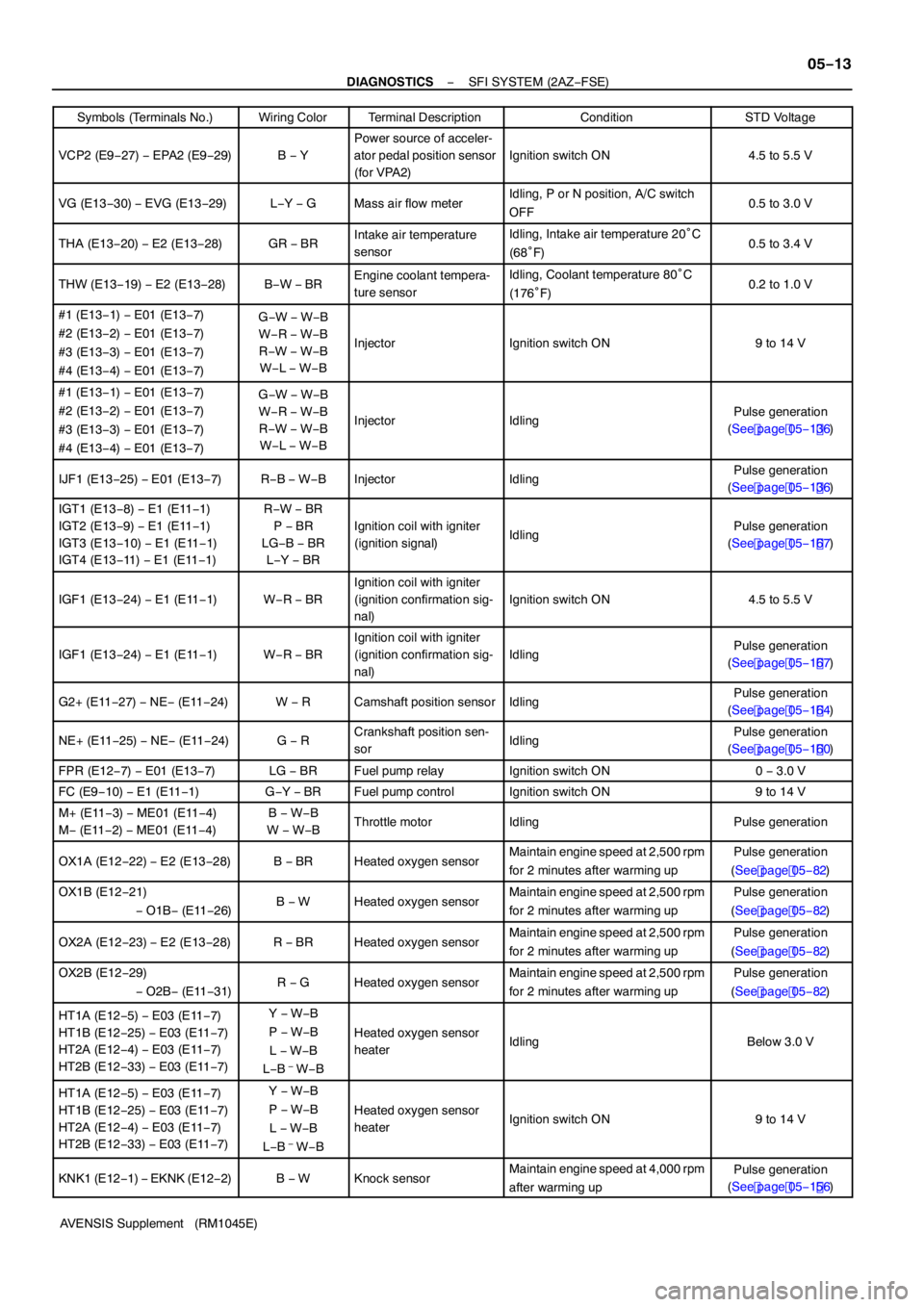2005 TOYOTA AVENSIS wiring
[x] Cancel search: wiringPage 4096 of 5135

A59779
C2
Camshaft Timing Oil
Control Valve1
2 ECM
W −G
OC1+
15
Y −B
OC1−
E11
16
E11
05 −42
−
DIAGNOSTICS SFI SYSTEM (2AZ−FSE)
AVENSIS Supplement (RM1045E)
WIRING DIAGRAM
INSPECTION PROCEDURE
HINT:
Read freeze frame data using the hand−held tester . Freeze frame data records the engine conditions when
a malfunction is detected. When troubleshooting, freeze frame data can help determine if the vehicle was
running or stopped, if the engine was warmed up or not, if the air −fuel ratio was lean or rich, and other data
from the time the malfunction occurred.
1 PERFORM ACTIVE TEST BY HAND −HELD TESTER(OPERATE OCV)
(a) Connect the hand −held tester to the DLC3.
(b) Start the engine and warm it up.
(c) Turn the ignition switch to ON and turn the hand −held tester ON.
(d) Select the item: DIAGNOSIS / OBD/MOBD / ACTIVE TEST / VVT CTRL B1.
(e) Using the hand −held tester, operate the OCV and check the engine speed.
Standard:
Tester OperationSpecified Condition
OCV is OFFNormal engine speed
OCV is ONRough idle or engine stall
OK CHECK FOR INTERMITTENT PROBLEMS (See Page 05 −7)
NG
2 INSPECT CAMSHAFT TIMING OIL CONTROL VALVE ASSY(OCV) (See page 10− 2)
NG REPLACE CAMSHAFT TIMING OIL CONTROL
VALVE ASSY
OK
Page 4112 of 5135

05CDW−02
A53766
E13E12E11E10E9
05−12
− DIAGNOSTICSSFI SYSTEM (2AZ−FSE)
AVENSIS Supplement (RM1045E)
TERMINALS OF ECM
Each ECM terminal’s standard normal voltage is shown in the table below.
In the table, first follow the information under ”Condition”. Look under ”Symbols (Terminals No.)” for the termi-
nals to be inspected. The standard normal voltage between the terminals is shown under ”STD Voltage”.
Use the illustration above as a reference for the ECM terminals.
Symbols (Terminals No.)Wiring ColorTerminal DescriptionConditionSTD Voltage
BATT (E9−3)−E1(E11−1)B−Y−BR
Battery (for measuring the
battery voltage and for the
ECM memory)
Always9to14V
+BM (E10−6)−E1(E11−1)G−Y−BRPower source of throttle
motorAlways9to14V
IGSW (E9−9)−E1(E11−1)B−W−BRIgnition switchIgnition switch ON9to14V
+B (E9−1)−E1(E11−1)B−R−BRPower source of ECMIgnition switch ON9to14V
+B2 (E9−2)−E1(E11−1)B−R−BRPower source of ECMIgnition switch ON9to14V
MREL (E9−8)−E1(E11−1)GR−BREFI relayIgnition switch ON9to14V
IREL (E10−35)−E1(E11−1)V−BRINJ relayIgnition switch ON9to14V
VC (E13−18)−E2 (E13−28)R−W−BRPower source of sensor
(a specific voltage)Ignition switch ON4.5 to 5.5 V
VTA1(E13−21)−E2 (E13−28)L−W−BRThrottle position sensor
(for the engine control)Ignition switch ON, Accelerator ped-
al fully released0.4 to1.0 V
VTA1(E13−21)−E2 (E13−28)L−W−BRThrottle position sensor
(for the engine control)Ignition switch ON, Accelerator ped-
al fully depressed3.2 to 4.8 V
VTA2 (E13−31)−E2 (E13−28)B−R−BR
Throttle position sensor
(for the sensor malfunc-
tion detection)Ignition switch ON, Accelerator ped-
al fully released2.1to 3.1V
VTA2 (E13−31)−E2 (E13−28)B−R−BR
Throttle position sensor
(for the sensor malfunc-
tion detection)Ignition switch ON, Accelerator ped-
al fully depressed4.5 to 5.5 V
VPA (E9−22)−EPA (E9−28)G−Y
Accelerator pedal position
sensor (for the engine
control)Ignition switch ON, Accelerator ped-
al fully released0.5 to1.1V
VPA (E9−22)−EPA (E9−28)G−Y
Accelerator pedal position
sensor (for the engine
control)Ignition switch ON, Accelerator ped-
al fully depressed2.5 to 4.6 V
VPA2 (E9−23)−EPA2 (E9−29)W−Y
Accelerator pedal position
sensor (for the sensor
malfunction detection)Ignition switch ON, Accelerator ped-
al fully released1.5 to 2.9 V
VPA2 (E9−23)−EPA2 (E9−29)W−Y
Accelerator pedal position
sensor (for the sensor
malfunction detection)Ignition switch ON, Accelerator ped-
al fully depressed3.5 to 5.5 V
VCPA (E9−26)−EPA (E9−28)B−Y
Power source of acceler-
ator pedal position sensor
(for VPA)
Ignition switch ON4.5 to 5.5 V
Page 4113 of 5135

−
DIAGNOSTICS SFI SYSTEM (2AZ−FSE)
05 −1 3
AVENSIS Supplement (RM 1045E)
Symbols (Terminals No.)
STD Voltage
Condition
Terminal Description
Wiring Color
VCP2 (E9 −27) −EPA2 (E9 −29)B −Y
Power source of acceler-
ator pedal position sensor
(for VPA2)
Ignition switch ON4.5 to 5.5 V
VG (E 13− 30) −EVG (E 13− 29)L− Y −GMass air flow meterIdling, P or N position, A/C switch
OFF0.5 to 3.0 V
THA (E 13− 20) −E2 (E 13− 28)GR −BRIntake air temperature
sensorIdling, Intake air temperature 20 ˚C
(68 ˚F)0.5 to 3.4 V
THW (E 13−1 9)−E2 (E 13− 28)B −W −BREngine coolant tempera-
ture sensorIdling, Coolant temperature 80 ˚C
(176˚F)0.2 to 1.0 V
#1 (E 13−1 )− E0 1(E 13− 7)
#2 (E 13− 2) −E0 1(E 13− 7)
#3 (E 13− 3) −E0 1(E 13− 7)
#4 (E 13− 4) −E0 1(E 13− 7)G −W −W −B
W −R −W −B
R −W −W −B
W −L − W −B
InjectorIgnition switch ON9to 14V
#1 (E 13−1 )− E0 1(E 13− 7)
#2 (E 13− 2) −E0 1(E 13− 7)
#3 (E 13− 3) −E0 1(E 13− 7)
#4 (E 13− 4) −E0 1(E 13− 7)G −W −W −B
W −R −W −B
R −W −W −B
W −L − W −B
InjectorIdlingPulse generation
(See page 05 −1 36)
IJF 1(E 13− 25) −E0 1(E 13− 7)R −B −W −BInjectorIdlingPulse generation
(See page 05 −1 36)
IGT 1(E 13− 8) −E1 (E 11−1 )
IGT2 (E 13− 9) −E1 (E 11−1 )
IGT3 (E 13−1 0)−E1 (E 11−1 )
IGT4 (E 13−11 )− E1 (E 11−1 )R−W −BR
P −BR
LG −B −BR
L − Y −BR
Ignition coil with igniter
(ignition signal)IdlingPulse generation
(See page 05 −1 67)
IGF 1(E 13− 24) −E1 (E 11−1 )W−R −BR
Ignition coil with igniter
(ignition confirmation sig-
nal)
Ignition switch ON4.5 to 5.5 V
IGF 1(E 13− 24) −E1 (E 11−1 )W−R −BR
Ignition coil with igniter
(ignition confirmation sig-
nal)
IdlingPulse generation
(See page 05 −1 67)
G2+ (E 11 −27) −NE −(E 11 − 24)W−RCamshaft position sensorIdlingPulse generation
(See page 05 −1 64)
NE+ (E 11 −25) −NE −(E 11 − 24)G−RCrankshaft position sen-
sorIdlingPulse generation
(See page 05 −1 60)
FPR (E 12− 7) −E0 1(E 13− 7)LG −BRFuel pump relayIgnition switch ON0−3.0 V
FC (E9 −10)−E1 (E 11−1 )G−Y −BRFuel pump controlIgnition switch ON9to 14V
M+ (E 11 −3)−ME0 1(E 11 − 4)
M − (E 11 − 2)−ME0 1(E 11 − 4)B−W −B
W −W −BThrottle motorIdlingPulse generation
OX 1A(E 12− 22) −E2 (E 13− 28)B −BRHeated oxygen sensorMaintain engine speed at 2,500 rpm
for 2 minutes after warming upPulse generation
(See page 05 −82)
OX 1B(E 12− 21)
− O1B − (E 11 − 26)B−WHeated oxygen sensorMaintain engine speed at 2,500 rpm
for 2 minutes after warming upPulse generation
(See page 05 −82)
OX2A (E 12− 23) −E2 (E 13− 28)R −BRHeated oxygen sensorMaintain engine speed at 2,500 rpm
for 2 minutes after warming upPulse generation
(See page 05 −82)
OX2B (E 12− 29)
− O2B −(E 11 − 31)R −GHeated oxygen sensorMaintain engine speed at 2,500 rpm
for 2 minutes after warming upPulse generation
(See page 05 −82)
HT 1A(E 12− 5) −E03 (E 11 −7)
HT 1B(E 12− 25) −E03 (E 11 −7)
HT2A (E 12− 4) −E03 (E 11 −7)
HT2B (E 12− 33) −E03 (E 11 −7)Y−W −B
P −W −B
L −W −B
L − B
−W −B
Heated oxygen sensor
heaterIdlingBelow 3.0 V
HT 1A(E 12− 5) −E03 (E 11 −7)
HT 1B(E 12− 25) −E03 (E 11 −7)
HT2A (E 12− 4) −E03 (E 11 −7)
HT2B (E 12− 33) −E03 (E 11 −7)Y−W −B
P −W −B
L −W −B
L − B
−W −B
Heated oxygen sensor
heaterIgnition switch ON9to 14V
KNK 1(E 12−1 )− EKNK (E 12− 2)B −WKnock sensorMaintain engine speed at 4,000 rpm
after warming upPulse generation
(See page 05 −1 56)
Page 4114 of 5135

05−1 4
−
DIAGNOSTICS SFI SYSTEM (2AZ−FSE)
AVENSIS Supplement (RM 1045E)
Symbols (Terminals No.)
STD Voltage
Condition
Terminal Description
Wiring Color
OC 1+(E 11−1 6)
− OC 1−(E11−1 5)W−G −Y−BCamshaft timing oil con-
trol valve (OCV)Ignition switch ONPulse generation
(See page 05 −41)
EVP 1(E 13− 34) −E0 1(E 13− 7)W −G −W −BVSV for EVAPIgnition switch ON9to 14V
SCV (E 13− 5) −E1 (E 11−1 )L− B −BRVSV for IACVIgnition switch ON9to 14V
PIM (E 13− 33) −E2 (E 13− 28)G −W −BRVacuum sensorIgnition switch ON3.3 to 3.9 V
PIM (E 13− 33) −E2 (E 13− 28)G −W −BRVacuum sensorApply vacuum of 26.7 kPa (200
mmHg, 7.9 in.Hg)2.6 to 3.0 V
PB (E 13− 26) −E2 (E 13− 28)Y −BRBrake booster pressure
sensorIgnition switch ON3.3 to 3.9 V
PB (E 13− 26) −E2 (E 13− 28)Y −BRBrake booster pressure
sensorApply vacuum of 26.7 kPa (200
mmHg, 7.9 in.Hg)2.6 to 3.0 V
PR (E 13− 23) −E2 (E 13− 28)Y −G −BRFuel pressure sensorIdling2.1 to 3.2 V
FP+ (E 12− 6) −E0 1(E 13− 7)
FP −(E 12− 3) −E0 1(E 13− 7)R −BR
G −BRSpill valveIdlingPulse generation
(See page 05 −207)
STA (E 13−1 7)−E1 (E 11−1 )B−Y −BRStarter signalShift position in neutral, Ignition
switch START6.0 V or more
STP (E 10−1 9)−E1 (E 11−1 )G−W −BRStop lamp switchBrake pedal depressed9to 14V
STP (E 10−1 9)−E1 (E 11−1 )G−W −BRStop lamp switchBrake pedal releasedBelow 1.5 V
ST 1− (E10−1 2)−E1 (E 11−1 )G−W −BRStop lamp switchIgnition switch ON, Brake pedal de-
pressedBelow 1.5 V
ST 1− (E10−1 2)−E1 (E 11−1 )G−W −BRStop lamp switchIgnition switch ON, Brake pedal re-
leased7.5 to 14V
W (E9 −11)− E1 (E 11−1 )W−W −BCHK ENGIdling9to 14V
W (E9 −11)− E1 (E 11−1 )W−W −BCHK ENGIgnition switch ONBelow 3.0 V
ELS (E9 −12)−E1 (E 11−1 )G−BRElectric loadTaillight switch ON, Defogger switch
ON7.5 to 14V
ELS (E9 −12)−E1 (E 11−1 )G−BRElectric loadTaillight switch OFF, Defogger
switch OFF0to 1.5 V
TACH (E9 −5) −E1 (E 11−1 )GR−R −BREngine speedIdlingPulse generation
SPD (E 10−1 7)−E1 (E 11−1 )V−W −W −BSpeed signal from com-
bination meterIgnition switch ON, Rotate driving
wheel slowly4.5 to 5.5 V
TC (E9 −20) −E1 (E 11−1 )W−L −BRTerminal TC of DLC 3Ignition switch ON9to 14V
SIL (E9 −18)−E1 (E 11−1 )W−G −BRTerminal SIL of DLC3Connect the hand −held tester to
DLC3Pulse generation
PSW (E 11−10)−E1 (E 11−1 )G−BRPower steering oil pres-
sure switchWhile turning the steering wheelBelow 1.5 V
F/PS (E9 −14)−E1 (E 11−1 )LG−B −BRAirbag sensor assemblyIgnition switch ONBelow 1.5 V
Page 4129 of 5135

A76882
Battery FL MAINIGN
B−G11
E9
2 6
Engine
Room
J/B No.4Engine Room
R/B No.1
AM2
1 2
B−G4
18Driver
Side J/B
B−W B−R
WECM
DH
DA B−R
B−R 1
1A 1
1
4A
1 4B(LHD) (RHD)IP1 IE41
1
I13
Ignition Switch
AM2
IG2
(LHD)J8C
(RHD)J26A
(LHD)J8C
(RHD)J26AB−WCheck
Engine
Warning
LightW
C11
Combination Meter
229
J/C Engine Room
J/B No.1
− DIAGNOSTICSSFI SYSTEM (2AZ−FSE)
05−251
AVENSIS Supplement (RM1045E)
CHECK ENGINE WARNING LIGHT CIRCUIT
CIRCUIT DESCRIPTION
The CHK ENG is used to indicate the ECM’s detection of a vehicle malfunction.
The instrument panel IGN fuse provides the circuit power and the ECM provides the circuit ground that illumi-
nates the CHK ENG.
CHK ENG operations should be checked visually:
The CHK ENG should be illuminated when the ignition is first turned to ON. If the CHK ENG is always ON
or OFF, use the hand−held tester and follow the procedures below to determine the cause of the problem.
WIRING DIAGRAM
INSPECTION PROCEDURE
HINT:
Troubleshoot each trouble symptom in accordance with the chart below.
CHK ENG remains onStart inspection from step1
CHK ENG is not illuminatedStart inspection from step 3
05CJB−02
Page 4131 of 5135

−
DIAGNOSTICS SFI SYSTEM (2AZ−FSE)
05 −249
AVENSIS Supplement (RM 1045E)
STARTER SIGNAL CIRCUIT
CIRCUIT DESCRIPTION
When the engine is cranked, the intake air flow is slow, so fuel vaporization is poor. A rich mixture is therefore
necessary in order to achieve good startability. While the engine is being cranked, the battery voltage is ap-
plied to terminal STA of the ECM. The starter signal is mainly used to increase the fuel injection volume for
the starting injection control and after −start injection control.
WIRING DIAGRAM
Refer to DTC P06 17 on page 05 −203.
INSPECTION PROCEDURE
HINT:
This diagnostic troubleshooting procedure is on the premise that the engine is being cranked under normal
conditions. If the engine does not crank, proceed to the problem symptoms table on page 05 −1 0.
1 READ VALUE OF HAND −HELD TESTER(STARTER SIGNAL)
(a) Connect the hand −held tester to the DLC3.
(b) Turn the ignition switch to ON and turn the hand −held tester ON.
(c) On the hand −held tester, select the item: DIAGNOSIS / OBD/MOBD / DATA LIST / ALL / STARTER
SIG. Read the values.
Result:
Ignition Switch PositionONSTART
STA SignalOFFON
OK PROCEED TO NEXT CIRCUIT INSPECTION SHOWN IN PROBLEM SYMPTOMS TABLE
(See page 05 −1 0)
NG
05CJC −02
Page 4133 of 5135

1
2
3
4
A93906
−
DIAGNOSTICS SFI SYSTEM (2AZ−FSE)
05 −24 1
AVENSIS Supplement (RM1045E)
FUEL PUMP CONTROL CIRCUIT
CIRCUIT DESCRIPTION
Refer to DTC P0230 on page 05 −141.
WIRING DIAGRAM
Refer to DTC P0230 on page 05 −141.
INSPECTION PROCEDURE
1 CHECK FUEL PUMP OPERATION (See page 11− 4)
(a) Check if there is pressure in the fuel inlet hose.
HINT:
If there is fuel pressure, you will hear the sound of fuel flowing.
OK Go to step 9
NG
2 PERFORM ACTIVE TEST BY HAND −HELD TESTER(OPERATION OF CIRCUIT
OPENING RELAY)
(a) Connect the hand −held tester to the DLC3.
(b) Start the engine and warm it up.
(c) Turn the ignition switch to ON.
(d) Select the item: DIAGNOSIS / OBD/MOBD / ACTIVE TEST / FUEL PUMP/SPD.
(e) Check the relay operation when it is operated by the hand −held tester.
Standard: Operating sound can be heard from the relay.
OK Go to step 4
NG
3 INSPECT RADIATOR FAN RELAY
(a) Remove the R21 radiator fan relay.
(b) Check for continuity in the radiator fan relay relay. Standard:
Tester ConnectionSpecified Condition
1−2Continuity
3−4Continuity
1−2No Continuity
(Apply battery voltage to terminals 3 and 4)
(c) Reinstall the radiator fan relay relay.
NG REPLACE FUEL PUMP RELAY
OK
05HIS −01
Page 4141 of 5135

A76879
IP1I13
Ignition Switch
IGN Driver Side J/B
E9
E11ECM
Battery FL MAINEFI
No. 1
2
B−G2
118
9
18 4DH
2
E9E9
1 12 31 5
EFI
Relay
D
EEBR GR B−W
DA
J/C 1A
J28IGSW
+B2 MREL
E1
Engine Room
J/B No. 41 4A
4BEngine Room
R/B No. 1 1EFI
AM2
1 211
1 2
B−G6
(RHD) IE4 1 (LHD)
B−R B−RB−R
4 4
4
4
4
4Engine Room
R/B No. 4
Engine
Room
R/B No. 4B−Y
B−W
B−R
ECW−B
B−RB−R B−R
(RHD) (LHD)
D J14D J28 (RHD)(LHD)
D J14
D
J28 D J141
E9 +B (RHD)
(LHD)B−W
B−W (RHD)
(LHD)B−W
J26A
J27E
J8
J/CJ/C
CC
IE12
GR
(LHD)(RHD)IP1 IE42
3
AM2 IG2
Engine Room
J/B No. 1 05−236
− DIAGNOSTICSSFI SYSTEM (2AZ−FSE)
AVENSIS Supplement (RM1045E)
ECM POWER SOURCE CIRCUIT
CIRCUIT DESCRIPTION
When the ignition switch is turned ON, the positive battery voltage is applied to terminal IGSW of the ECM
and the EFI relay (Markied: EFI) control circuit in the ECM sends a signal to terminal MREL of the ECM
switching on the EFI relay.
This signal causes current to flow to the coil, closing the contacts of the EFI relay and supplying power to
terminals +B and +B2 of the ECM.
If the ignition switch is turned OFF, the ECM holds the EFI relay on for maximum of 2 seconds to allow for
the initial setting of the throttle valve.
WIRING DIAGRAM
05CK0−02